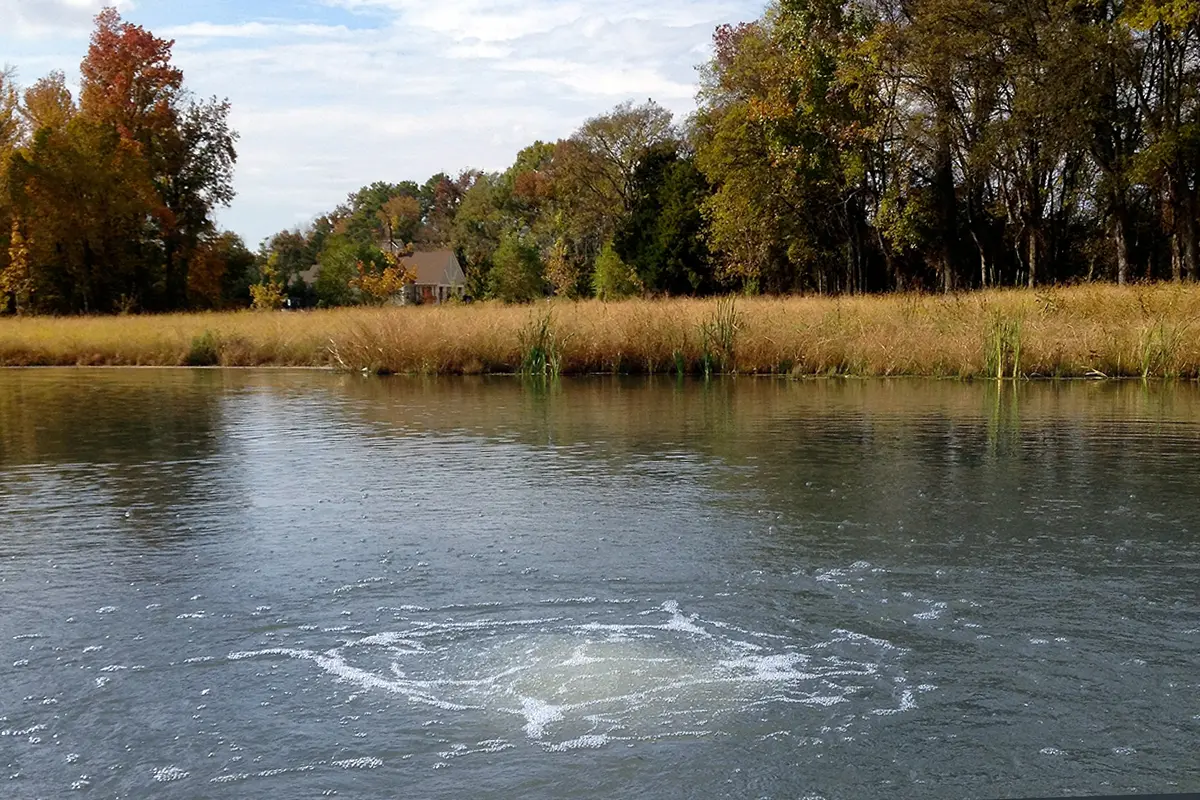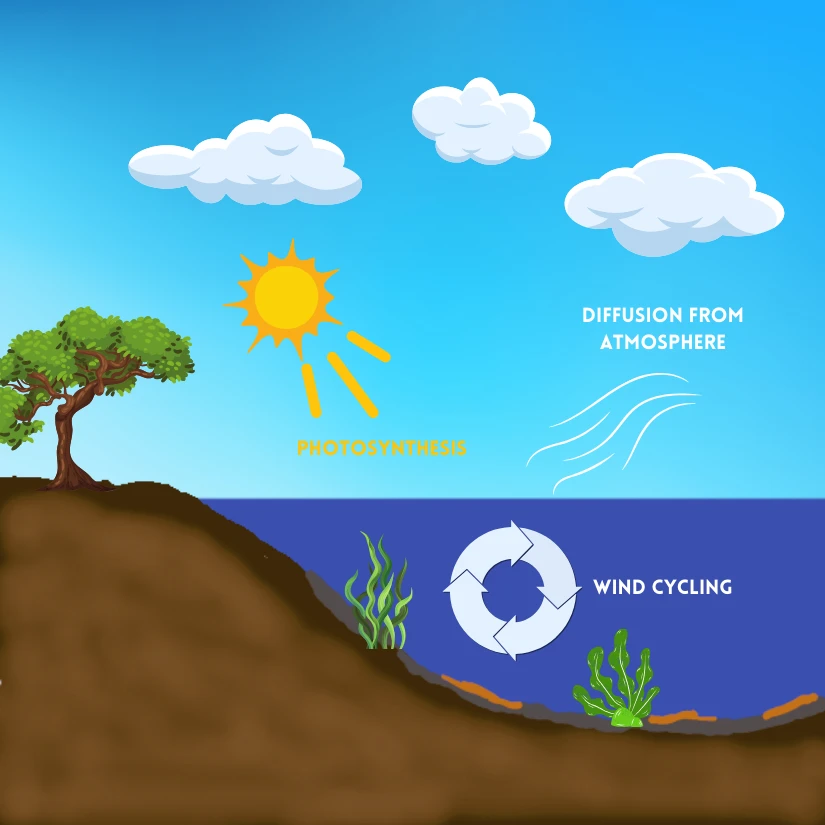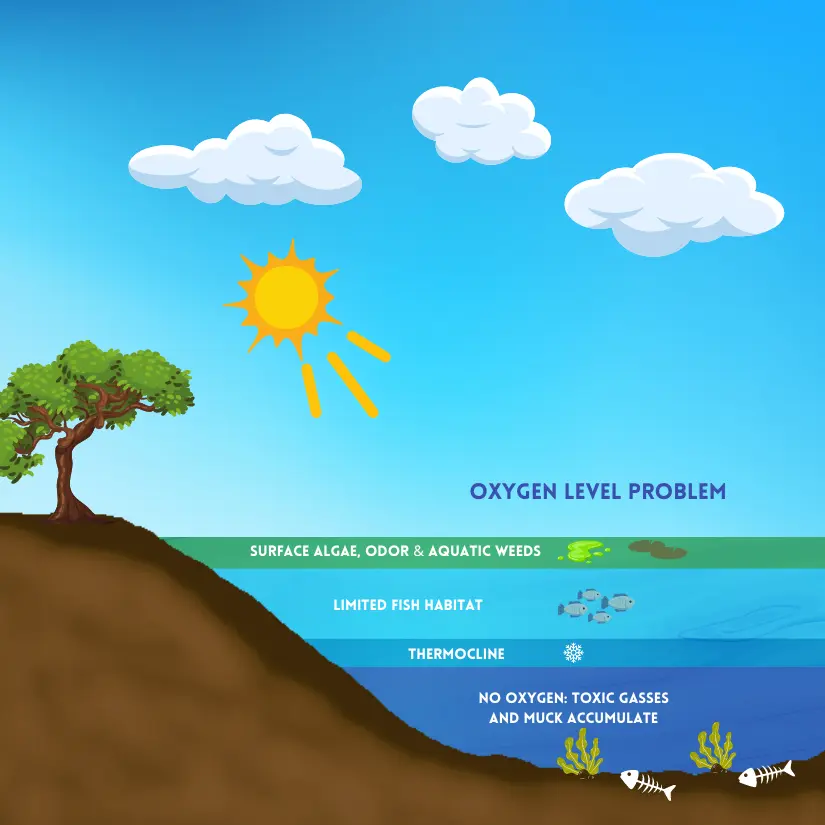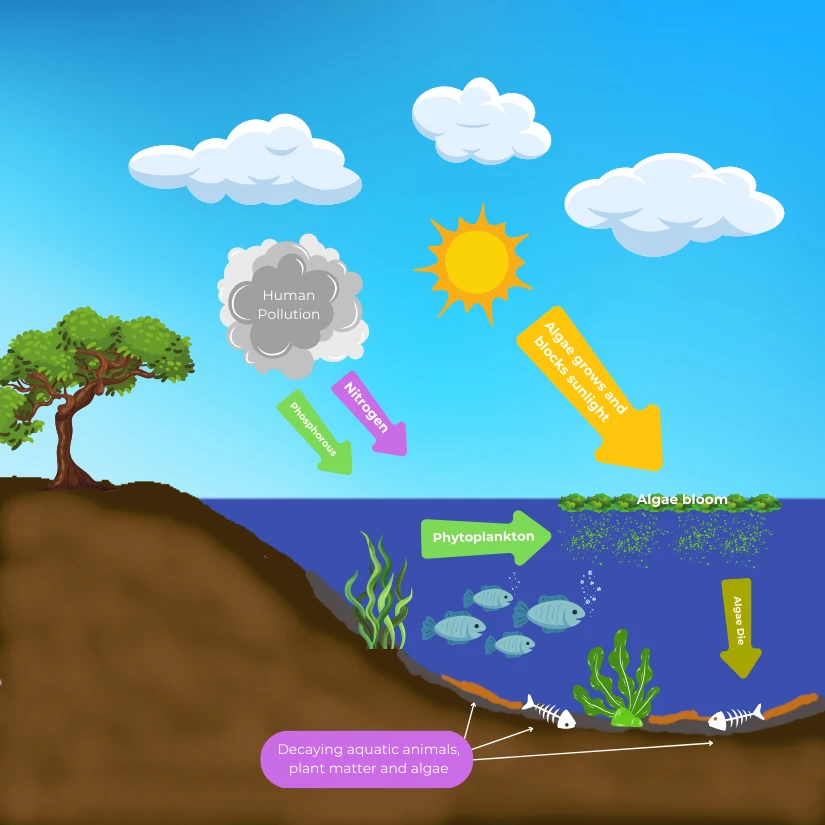Introduction
Pond owners have a goal of creating and maintaining aquatic ecosystems that are both visually appealing and full of life. These ecosystems are home to a diverse range of organisms, including fish, insects, microorganisms, and aquatic plants, all of which require oxygen to survive. When the oxygen supply in a pond is unstable, the ecosystem’s health and balance are negatively affected. On the other hand, consistent oxygen levels promote the attractiveness and productivity of ponds. Therefore, the most beneficial investment for pond owners is a dependable 24/7 aeration system that guarantees a sufficient supply of oxygen. This system is essential for supporting the vitality of the ecosystem and ensuring that the pond remains healthy and thriving.

An example of surface boil created by a sub-surface aeration diffuser
Oxygen – The Need Explained
Oxygen is vital for the well-being of lakes and ponds due to several key reasons:
- Aquatic Organisms’ Respiration: Fish, insects, and microorganisms in aquatic ecosystems require oxygen for respiration, just like land animals. Insufficient oxygen can lead to suffocation and death.
- Fish and Wildlife Survival: Fish, especially, rely on dissolved oxygen. Low oxygen levels can stress fish, hampering growth and causing mortality. Adequate oxygen supports a diverse range of aquatic species.
- Decomposition of Organic Matter: Lakes and ponds receive organic matter like dead plants and animal waste. Oxygen is essential for decomposition. Low oxygen can slow this process, leading to organic debris accumulation and undesirable byproducts.
- Nutrient Balance: Oxygen regulates nutrient cycles in aquatic ecosystems, preventing excessive algae growth (eutrophication). Oxygen-depleted conditions can lead to harmful algal blooms.
- Oxygen Minimum Zones: Some deep water bodies have oxygen minimum zones, limiting the range of thriving species and affecting ecosystem dynamics.
- Temperature and Oxygen Relationship: Oxygen solubility decreases as water temperature rises, potentially stressing aquatic life during high temperatures.
- Photosynthesis and Oxygen Production: Aquatic plants, including algae, produce oxygen during photosynthesis in well-lit, shallow areas, helping to replenish oxygen levels.
- Water Circulation: Wind and currents can distribute oxygen-rich surface water to deeper areas, aiding in oxygen diffusion.
Oxygen is vital for maintaining the health and balance of aquatic ecosystems, supporting diverse life forms, regulating nutrients, and ensuring proper functioning.
Lakes and Ponds – Without Aeration Systems
In natural conditions without aeration systems, lakes and ponds rely on the oxygen cycle. This vital process involves oxygen exchange between water, the atmosphere, and aquatic life. Here’s an overview:
- Photosynthesis: Aquatic plants, like algae, perform photosynthesis during daylight hours. They convert carbon dioxide and water into glucose and oxygen, releasing oxygen into the water.
- Oxygen Dissolution: Oxygen from the atmosphere dissolves into the surface water, mainly at the air-water interface. Factors like wind and surface agitation enhance this process, supplying oxygen for aquatic respiration.
- Respiration: Aquatic organisms, including fish and microorganisms, respire by taking in oxygen from the water and releasing carbon dioxide as they break down organic compounds for energy.
- Oxygen Depletion: As organisms respire and organic matter decomposes, dissolved oxygen decreases in the water. This can easily result in and oxygen depletion, especially during the summer months. Oxygen depletions are common occurrences in lakes and ponds without aerations systems, and usually result in a partial or total fish kill.
- Vertical Mixing and Circulation: Lakes often have temperature stratification, but mixing due to wind or temperature changes can bring oxygen-rich surface water to deeper areas, replenishing oxygen levels.
- Oxygen Minimum Zones: Some lakes, especially deep ones, may have oxygen minimum zones where levels are lower due to reduced sunlight and limited circulation, hosting organisms adapted to low-oxygen conditions.
- Seasonal Variations: Seasonal changes can affect the oxygen cycle. Colder temperatures increase oxygen capacity, but ice cover can limit gas exchange, potentially leading to oxygen depletion.
The oxygen cycle in lakes and ponds involves a complex interplay of photosynthesis, respiration, dissolution, decomposition, and physical processes like mixing. Maintaining proper oxygen levels is crucial for aquatic ecosystem health and sustainability.

The diagram above illustrates how oxygen enters the water and how currents circulate it throughout the water column.

The diagram above illustrates various oxygen requirements in natural lakes and ponds without proper aeration.

The diagram above illustrates how lakes and ponds go through the eutrophication process. When aeration systems are added, the speed of this process increases exponentially, giving superior long-term benefits to the lake or pond.
Lakes and Ponds – With Aeration Systems
Aquatic ecosystems like lakes and ponds are teeming with life, including fish, plants, and various organisms. These creatures rely on oxygen to thrive, which means these environments have a constant need for oxygen. It’s not a question of “if,” but “when” pond owners might face fish kills due to oxygen depletion, a common problem.

The diagram above illustrates how a sub-surface aeration system eliminates stratification and introduces oxygen to the entire water column.
Aeration, the process of exposing water to air (which contains oxygen), is the solution. Nature achieves this through wind-induced waves in large water bodies, creating currents and oxygenating the water. Sub-surface aeration, however, offers a unique advantage. It creates an airlift current from the pond’s bottom to the top, introducing oxygen through countless tiny bubbles. These bubbles originate from self-cleaning flexible membrane diffusers, efficiently aerating the pond by de-stratification.
The Science Behind Sub-surface Aeration
Water aeration, essential for aquatic life, involves exposing water to oxygen-rich air. In nature, wind creates waves that both circulate water and oxygenate it. Sub-surface aeration stands out by creating an airlift current from the pond’s bottom, introducing oxygen through countless tiny bubbles via self-cleaning flexible membrane diffusers. This cost-effective method, called de-stratification, results from extensive underwater current flow analysis, efficiently lifting water from the bottom to the surface with minimal energy.
Benefits of Sub-surface Aeration:
- Superior Oxygenation Efficiency: It provides the best oxygen efficacy, meaning it generates more oxygen per horsepower of energy and is therefore the most efficient and cost effective method of aeration for lakes and ponds. This efficiency is due to the large surface area created by countless tiny bubbles contacting the water, reducing energy costs.
- Oxidation of Waste: Ponds accumulate organic waste at the bottom, which requires oxygen for decomposition. Sub-surface aeration prevents pond turnovers by consistently introducing oxygen to the bottom, minimizing silt buildup and protecting fish.
- Water Circulation and De-Stratification: The airlift current eliminates thermoclines (temperature variations in the water), ensuring oxygen distribution throughout the pond. Surface aerators can’t achieve this.
- Water Purification: The current exposes water to sunlight, which destroys harmful bacteria, improving water quality.
- Enhanced Water Quality: By providing oxygen and reducing waste, sub-surface aeration promotes the growth of beneficial aerobic bacteria, leading to a healthier aquatic environment.
- Aids in Algae Reduction: Aeration reduces nutrient levels, starving algae and reducing their presence. This can save on chemical algae control costs.
How Sub-Surface Aeration Manifolds Work

- Surface Boil – The surface boil rises 2 inches from water kinetic energy, travels over 100 feet outward, then circles back clockwise to the pond bottom, restarting the cycle.
- Recirculating Current – Millions of tiny bubbles rise through the water, creating an upward airlift current while supplying oxygen through diffusion.
- Diffuser Manifold – The diffuser manifold sits at the pond bottom, connected to the compressor on the bank. Air is continuously pumped through it, creating an airlift current that draws poorly oxygenated water upward. Our Vertex bottom aeration systems use small bubbles from self-cleaning diffusers to create a vertical current, effectively “turning over” the lake and oxygenating its surface.
Investing in sub-surface aeration enhances the overall health and quality of your pond or lake, benefiting both aquatic life and recreational activities.
